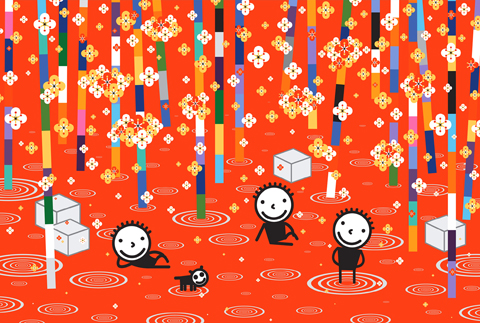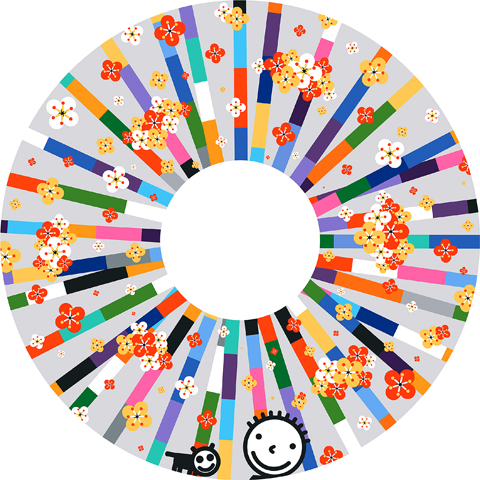Kwon Ki-soo seems to be playing a joke on the observer.
When looking at his paintings online or in print, a person could be forgiven for thinking they were illustrations from a children’s book (many South Korean critics have done just that). The bold colors, simple shapes and figures lend the paintings an infantile quality perhaps more suited to a nursery school than an art gallery.
Standing in front of the large acrylic canvasses at Metaphysical Art Gallery, however, provides the viewer with a different perspective altogether because what at first appears to be cartoonish flora and a comic book character is replaced with works of meditative simplicity that employ techniques and forms of Korean painting that date back hundreds of years. And yet the playfulness remains.

PHOTO COURTESY OF METAPHYSICAL ART GALLERY
The exhibit’s title, Who’s Dongguri?, challenges the viewer to ponder the relationship between the figure, its background and a tradition of painting that has changed little over the centuries.
Kwon, who trained in classical Korean painting at Seoul’s Hongik University, draws on two classical styles of art, sumi and sansui, in his work. Sumi is a form of ink painting that employs four central motifs — plum blossoms, orchids, chrysanthemums and bamboo — to symbolically illustrate the meditative and scholarly life of Korea’s literati.
With sansui, or landscape painting, artists rely on their own impressions of nature’s logic and laws to express a transcendent image of what is actually seen. In other words, the painter paints what he feels as much as what he sees.

PHOTO COURTESY OF METAPHYSICAL ART GALLERY
Kwon infuses these forms and motifs onto his paintings and adds a visual vocabulary in line with Animamix art, most clearly discernible in Dongguri, a smiley-faced and genderless figure that appears on all canvases either by itself, with a dog, or with a coterie of Dongguri imitations who appear to be living a life free of worries.
Red Forest Rest is a classic example of Kwon moving beyond the confines of Korean art while still remaining within its tradition. It presents four Dongguri figures lounging on the forest floor, surrounded by a colorful bamboo thicket. Interspersed among the bamboo are grey rocks, here seen as cubes, prized in traditional Korean painting for their abstract quality. Though the traditional motifs remain, they are given new life and color in a manner similar to graphic design.
Dongguri’s smiling face alludes to the bearing Koreans (and by extension, Asians) often adopt toward others, especially superiors. The repetitive fixed expression of Dongguri, Kwon seems to suggest, mirrors a society that seeks harmony under a banner of conformity — a prison from which social norms don’t allow the individual to escape.
Kwon’s stark Airplane series dispenses with sumi and sansui and is a nod at the Korean War. It shows rows of featureless planes filling the sky, each piloted by Dongguri. The irony of the smiling figures, apparently willing to participate in an ideological conflict, contrasts with the stark purple, green and red of the sky and the threatening lines of planes flying overhead.
The answer to the question “Who’s Dongguri” is, like art itself, pretty much decided by the individual. For this reviewer, Kwon’s paintings are a statement against tradition and how lack of change imposes a stagnant conformity on people. Kwon’s canvases make a leap beyond tradition — though perhaps a leap that goes too far — and in the process allows room for Korean art to grow in new directions.
EXHIBITION NOTES:
WHAT: Who’s Dongguri?
WHERE: Metaphysical Art Gallery, (形而上畫廊), 7F, 219, Dunhua
S Rd Sec 1, Taipei City (台北市敦化南路一段219號7樓)
WHEN: Until Aug. 5
DETAILS: Open Tuesdays through Sundays, from 11am to 6:30pm
On the Net: www.artmap.com.tw

The Democratic Progressive Party (DPP), Chinese Nationalist Party (KMT), and the country’s other political groups dare not offend religious groups, says Chen Lih-ming (陳立民), founder of the Taiwan Anti-Religion Alliance (台灣反宗教者聯盟). “It’s the same in other democracies, of course, but because political struggles in Taiwan are extraordinarily fierce, you’ll see candidates visiting several temples each day ahead of elections. That adds impetus to religion here,” says the retired college lecturer. In Japan’s most recent election, the Liberal Democratic Party lost many votes because of its ties to the Unification Church (“the Moonies”). Chen contrasts the progress made by anti-religion movements in

Last week the State Department made several small changes to its Web information on Taiwan. First, it removed a statement saying that the US “does not support Taiwan independence.” The current statement now reads: “We oppose any unilateral changes to the status quo from either side. We expect cross-strait differences to be resolved by peaceful means, free from coercion, in a manner acceptable to the people on both sides of the Strait.” In 2022 the administration of Joe Biden also removed that verbiage, but after a month of pressure from the People’s Republic of China (PRC), reinstated it. The American

Chinese Nationalist Party (KMT) legislative caucus convener Fu Kun-chi (傅?萁) and some in the deep blue camp seem determined to ensure many of the recall campaigns against their lawmakers succeed. Widely known as the “King of Hualien,” Fu also appears to have become the king of the KMT. In theory, Legislative Speaker Han Kuo-yu (韓國瑜) outranks him, but Han is supposed to be even-handed in negotiations between party caucuses — the Democratic Progressive Party (DPP) says he is not — and Fu has been outright ignoring Han. Party Chairman Eric Chu (朱立倫) isn’t taking the lead on anything while Fu

Feb 24 to March 2 It’s said that the entire nation came to a standstill every time The Scholar Swordsman (雲州大儒俠) appeared on television. Children skipped school, farmers left the fields and workers went home to watch their hero Shih Yen-wen (史艷文) rid the world of evil in the 30-minute daily glove puppetry show. Even those who didn’t speak Hoklo (commonly known as Taiwanese) were hooked. Running from March 2, 1970 until the government banned it in 1974, the show made Shih a household name and breathed new life into the faltering traditional puppetry industry. It wasn’t the first